![]()
![]()
![]()
Use LEFT and RIGHT arrow keys to navigate between flashcards;
Use UP and DOWN arrow keys to flip the card;
H to show hint;
A reads text to speech;
64 Cards in this Set
- Front
- Back
|
altarpiece
|
A painted or carved work of art
placed behind and above the altar of a Christian church. It may be a single panel or a triptych or a polytych, both having hinged wings painted on both sides. |
|
|
baptistry
|
In Christian architecture the baptistry or baptistery is the separate centrally-planned structure surrounding the baptismal font.
|
|
|
basilica
|
In Christian architecture, a longitudinal church derived from the Roman basilica and having a nave, an apse, two or four side aisles or side chapels, and sometimes a narthex.
|
|
|
cathedral
|
The church of a bishop; his admin-
istrative headquarters. The location of his cathedra or throne. |
|
|
chapel
|
A dedicated chamber within a building
|
|
|
city-state
|
A region that is ind. ruled by one city: during the Renaissance, Italy's most important city states were Rome, Florence, Venice, Naples.
|
|
|
donor
|
One who would commission the artwork. Often who is depicted in the work.
ex) Medici's in Italy |
|
|
Franciscan order
|
Order that St. Francis belonged to. Unlike the orders of monks of the past, they did not retreat from the world, but engaged with it. They worked in the cities to bring deeper spirituality and comfort to the poor. Taking vows
of poverty, Franciscans were committed to teaching the laity and to encouraging them to pursue spiritual growth. Toward this goal, they told stories and used images to explain and affirm the teachings of the Church. Characteristically, Franciscans urged the faithful to visualize events such as the Nativity in tangible ways, including setting up Nativity scenes (crèches) in churches as an aid to devotion. Both orders played important roles in late medieval religious and artistic life, though the Franciscans held a special place in Italy since their founder was a native son. |
|
|
fresco
|
Italian word for “fresh.” Fresco is the
technique of painting on plaster with pigments ground in water so that the paint is absorbed by the plaster and becomes part of the wall itself. Buon fresco is the technique of painting on wet plaster; fresco secco is the technique of painting on dry plaster. |
|
|
gold leaf
|
Especially common in Italian Late Gothic works, i.e. Madonna Enthroned.
Used to create life-like qualities, show majesty, |
|
|
modeling
|
ask Jason
|
|
|
naturalism
|
A style of art that aims to depict the natural world as it appears. Starts in Italian Late Gothic; increases throughout Renaissance.
|
|
|
panel
|
wood base that tempera or fresco would then be painted on. Precursor to canvas. Heavy, hard to maintain.
|
|
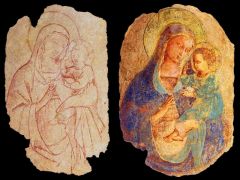
sinopia
|
Reddish sketch that underlies many frescos. Many uncovered during preservation removals of frescos from their original surfaces.
|
|
|
tempera painting
|
Medium for painting in which pigments are suspended in egg yolk tempered with water or chemicals; this mixture dries quickly, reducing the possibility of changes in the finished painting.
|
|
|
glaze
|
A thin layer of translucent oil color applied to a painted surface or to parts of it in order to modify the tone.
|
|
|
iconography
|
The depicting of images in art in order to convey certain meanings.
|
|
|
labors of the month
|
In illuminated manuscripts, the Book of Hours: the labors of the month are the seasonal actions that the picture is depicting: i.e. harvesting, feasting, courtly love, etc.
|
|
|
manuscript illumination
|
Decoration of handwritten documents, scrolls, or books with drawings or paintings. Illuminated manuscripts were often produced during the Middle Ages.
|
|
|
oil painting
|
Technique that originated with the Northern Renaissance and Flemish painters.
Oil absorbs light, and dries slowly, making it appropriate for detail. Gives the artist flexibility. |
|
|
perspective
|
A system for representing spatial relationships and three-dimensional objects on a flat two-dimensional surface so as to produce an effect similar to that perceived by the human eye. In atmospheric or aerial perspective, this is accomplished by a gradual decrease in the intensity of color and value and in the contrast of light and dark as objects are depicted as farther and farther away in the picture. In color artwork, as objects recede into the distance, all colors tend toward a light bluish-gray tone. In scientific or linear perspective, developed in Italy in the 15th century, a mathematical system is used based on orthogonals receding to vanishing points on the horizon. Transversals intersect the orthogonals at right angles at distances derived mathematically. Since this presupposes an absolutely stationary viewer and imposes rigid restrictions on the
artist, it is seldom applied with complete consistency. Traditionally ascribed to Brunelleschi. |
|
|
polyptych
|
An altarpiece or devotional work of art made of several panels joined together, often hinged.
|
|
|
triptych
|
An altarpiece or devotional picture, either carved or painted, with one central panel and two hinged wings.
|
|
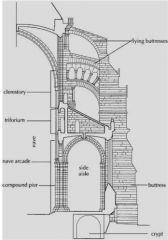
buttress
|
A projecting support built against an
external wall, usually to counteract the lateral thrust of a vault or arch within. In Gothic church architec- ture, a flying buttress is an arched bridge above the aisle roof that extends from the upper nave wall, where the lateral thrust of the main vault is greatest, down to a solid pier. |
|
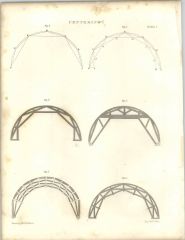
centering
|
A wooden framework built to support an arch, vault, or dome during its construction.
|
|
|
classicism
|
Art or architecture that harkens back to and relies upon the style and canons of the art and architecture of ancient Greece or Rome, which emphasize certain standards of balance, order, and beauty.
Increased throughout the Renaissance. |
|
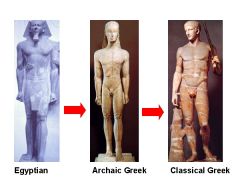
contrapposto
|
Italian word for “set against.”
A composition developed by the Greeks to represent movement in a figure. The parts of the body are placed asymmetrically in opposition to each other around a central axis, and careful attention is paid to the distribution of weight. |
|
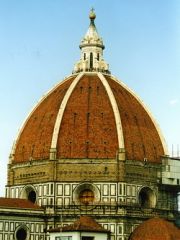
dome
|
A true dome is a vaulted roof of circular,
polygonal, or elliptical plan, formed with hemispher- ical or ovoidal curvature. May be supported by a cir- cular wall or drum and by pendentives or related constructions. Domical coverings of many other sorts have been devised. |
|
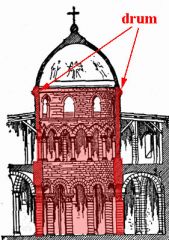
drum
|
(1) A section of the shaft of a column. (2) A circular-shaped wall supporting a dome.
|
|
|
engraving
|
A print made by cutting a design into a metal
plate (usually copper) with a pointed steel tool known as a burin. The burr raised on either side of the incised line is removed. Ink is then rubbed into the V-shaped grooves and wiped off the surface. The plate, covered with a damp sheet of paper, is run through a heavy press. The image on the paper is the reverse of that on the plate. When a fine steel needle is used instead of a burin and the burr is retained, a dry- point engraving results, characterized by a softer line. These techniques are called, respectively, engraving and drypoint. |
|
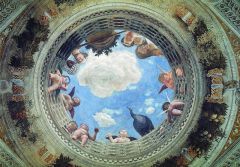
foreshortening
|
A method of reducing or distorting the parts of a represented object that are not parallel to the picture plane in order to convey the impression of three dimensions as perceived by the human eye.
|
|
|
illusionism
|
what scientific perspective accomplishes. Creating the illusion of space. Fooling the eye.
|
|
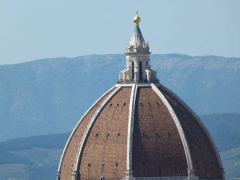
lantern
|
A relatively small structure crowning a
dome, roof, or tower, frequently open to admit light to an enclosed area below. |
|
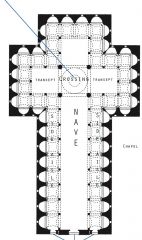
Latin cross (plan)
|
A cross in which three arms are of equal length and one arm is longer.
|
|
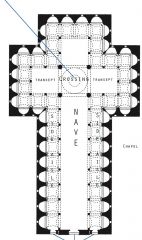
nave
|
The central aisle of a Roman basilica, as
distinguished from the side aisles. |
|
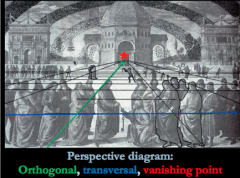
orthogonal
|
In a perspective construction, an imagined line in a painting that runs perpendicular to the picture plane and recedes to a vanishing point.
|
|

picture plane
|
ask Jason
|
|
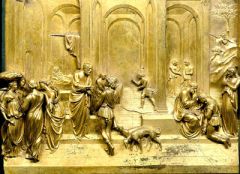
relief
|
The projection of a figure or part of a
design from the background or plane on which it is carved or modeled. Sculpture done in this manner is described as “high relief” or “low relief” depending on the height of the projection. When it is very shal- low, it is called schiacciato, the Italian word for “flat- tened out.” |
|
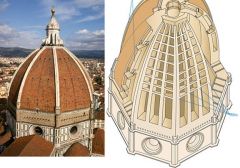
rib
|
Surface arches, known as ribs, are raised along the
intersections of segments of the vault. Ribs may pro- vide architectural support as well as decoration to the vault’s surface. |
|
|
rustication
|
A masonry technique of laying
rough-faced stones with sharply indented joints. |
|
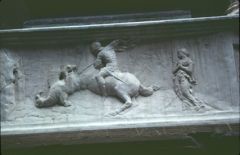
schiacciato
|
Italian for “flattened out.”
Describes low relief sculpture used by Donatello and some of his contemporaries. |
|
|
thrust
|
outward force created by a vertical building: why buttresses are built to hold up and keep from collapsing
|
|
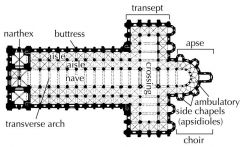
transept
|
A cross arm in a basilican church placed at right angles to the nave and usually separating it from the choir or apse.
|
|
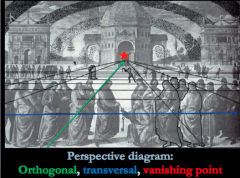
transversals
|
In a perspective construction, transversals are the lines parallel to the picture plane (horizontally) that denote distances. They intersect orthogonals to make a grid that guides the arrangement of elements to suggest space.
|
|
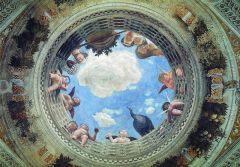
trompe l'oeil
|
Meaning “trick of the eye” in French, it is a work of art designed to deceive a viewer into believing that the work of art is reality, an actual three-dimensional object or scene in space.
|
|
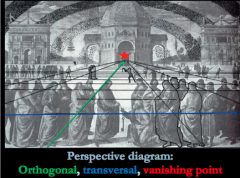
vanishing point
|
The point at which the orthogonals meet and disappear in a composition done with scientific perspective.
|
|
|
cartoon
|
From the Italian word cartone, meaning “large paper.” A full-scale drawing for a picture or design intended to be transferred to a wall, panel, tapestry, etc.
|
|
|
chiaroscuro
|
Italian word for “light and dark.” In painting, a method of modeling form primarily by the use of light and shade.
|
|
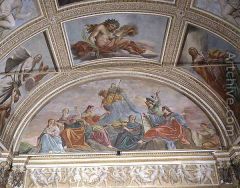
lunette
|
(1) A semicircular or pointed wall area,
as under a vault, or above a door or window. When it is above the portal of a medieval church, it is called a tympanum. (2) A painting, relief sculpture, or win- dow of the same shape. |
|
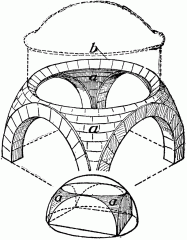
pendentives
|
One of the concave triangles that
achieves the transition from a square or polygonal opening to the round base of a dome or the support- ing drum. |
|
|
pouncing
|
A technique for transferring a drawing from a cartoon to a wall or other surface by pricking holes along the principal lines of the drawing and forcing fine charcoal powder through them onto the surface of the wall, thus reproducing the design on the wall.
|
|
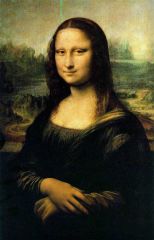
sfumato
|
Italian word meaning “smoky.” Used to describe very delicate gradations of light and shade in the modeling of figures. It is applied especially to the work of Leonardo da Vinci.
|
|
|
sibyls
|
Pagan prophets, on the ceiling of the Sistine Chapel
|
|
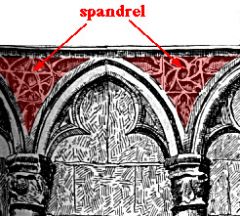
spandrel
|
The area between the exterior curves
of two adjoining arches or, in the case of a single arch, the area around its outside curve from its springing to its keystone. |
|
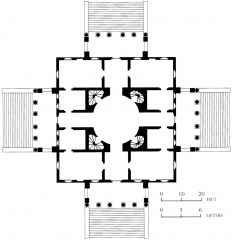
Central-plan church
|
idea used from antiquity by Palladio for Villa Routunda. A centralized building: normally a church. Using it in a secular manner was very unusual.
|
|
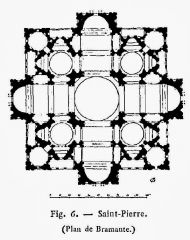
Greek cross
|
A cross with four arms of equal length arranged at right angles.
|
|
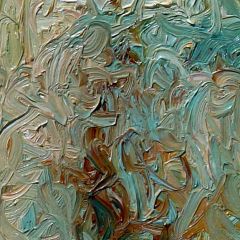
impasto
|
From the Italian word meaning “to make into a paste”; it describes paint, usually oil paint, applied very thickly.
|
|
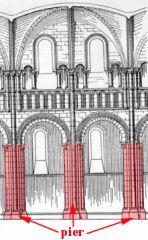
pier
|
An upright architectural support, usually
rectangular and sometimes with capital and base. When columns, pilasters, or shafts are attached to it, as in many Romanesque and Gothic churches, it is called a compound pier. |
|
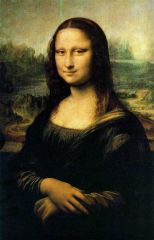
aerial perspecitive
|
refers to the effect the atmosphere has on the appearance of an object as it is viewed from a distance. As the distance between an object and a viewer increases, the contrast between the object and its background decreases, and the contrast of any markings or details within the object also decreases. The colours of the object also become less saturated and shift towards the background color
|
|
|
crosshatching
|
technique used in woodcutting or engraving to create depth, detail, perspective.
|
|
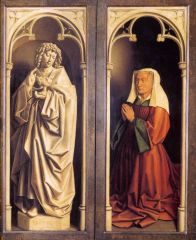
grisaille (left)
|
A monochrome drawing or painting in which only values of black, gray, and white are used.
Ghent Altarpiece: to make it look like statues |
|
|
print
|
Reproduced image, via a woodcut or engraving. Made possible vast reproduction and distribution in late Renaissance.
|
|
|
Reformation
|
Began with Martin Luther's posting. The spiritual challenge of the Reformation and the rise of
powerful courts affected Italian artists in this period by changing the climate in which they worked and the nature of their patronage. No single style dominated the sixteenth century in Italy, though all the artists working in what is conventionally called the Late Renaissance were profoundly affected by the achievements of the High Renaissance. |
|
|
woodcut
|
A print made by carving out a design on a wooden block cut along the grain, applying ink to the raised surfaces that remain, and printing from those.
|

